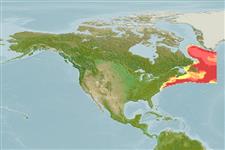>
Lophiiformes (Anglerfishes) >
Oneirodidae (Dreamers)
Etymology: Oneirodes: Greek, 'oneiros' = a dream or dreamlike or out of a dream (suggesting this fish is so strange and marvelous that can exist only in dreams) (Ref. 86949).
Environment: milieu / climate zone / depth range / distribution range
Écologie
marin bathypélagique; profondeur 0 - 1829 m (Ref. 58018). Deep-water
Northwest Atlantic: south of Newfoundland, Canada. Also recorded from Georges Bank, USA (Ref. 86949).
Taille / Poids / Âge
Maturity: Lm ? range ? - ? cm
Max length : 12.8 cm SL (female)
Description synthétique
Clés d'identification | Morphologie | Morphométrie
Rayons mous dorsaux (Total) : 5; Rayons mous anaux: 4. Esca of this species comprises a single, short, unpigmented medial appendage with 16 short filaments, an elongate anterior appendage which is branched at the tip, and no lateral and antero-lateral appendages. Anterior appendage with pigment internally for about one-half its length, with a paired eye-spot at tip of the pigment. There is also a paired eye-spot in the dorsal pigment patch of the escal bulb (Ref. 12204). Characterized further by having subopercle without indentation on posterodorsal margin; length of ventral fork of opercle 25.0-30.0% SL; ratio of lengths of the dorsal and ventral forks of opercle 0.46-0.55; absence of epibranchial teeth; well toothed pharyngobranchial II; upper jaw teeth 36-44, lower jaw teeth 34-39; teeth on vomer 6; dorsal fin rays 5; anal fin rays 4; pectoral fin rays 15-16; head length 38.0-44.4% SL; head depth 44.5-49.8% SL; head width 25.8-34.7%SL; premaxilla length 30.5-35.6% SL; length of lower jaw 43.0-51.1% SL; length of illicium 15.6% SL (Ref. 86949).
Life cycle and mating behavior
Maturities | Reproduction | Spawnings | Egg(s) | Fecundities | Larves
Coad, B.W., 1995. Encyclopedia of Canadian fishes. Canadian Museum of Nature and Canadian Sportfishing Productions Inc. Singapore. (Ref. 12204)
Statut dans la liste rouge de l'IUCN (Ref. 130435)
Menace pour l'homme
Harmless
Utilisations par l'homme
Outils
Articles particuliers
Télécharger en XML
Sources Internet
Estimates based on models
Preferred temperature (Ref.
123201): 2.4 - 4.8, mean 3.2 °C (based on 50 cells).
Phylogenetic diversity index (Ref.
82804): PD
50 = 0.5000 [Uniqueness, from 0.5 = low to 2.0 = high].
Bayesian length-weight: a=0.01995 (0.00906 - 0.04395), b=3.01 (2.83 - 3.19), in cm total length, based on all LWR estimates for this body shape (Ref.
93245).
Niveau trophique (Ref.
69278): 4.1 ±0.7 se; based on size and trophs of closest relatives
Résilience (Ref.
120179): Milieu, temps minimum de doublement de population : 1,4 à 4,4 années (Preliminary K or Fecundity.).
Fishing Vulnerability (Ref.
59153): Low vulnerability (10 of 100).
